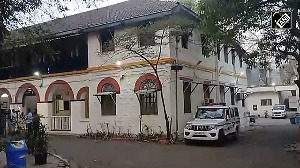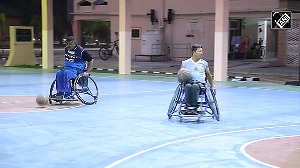This rare response in the cricket-mad nation was caused by the unprecedented participation of an Indian teenager in the final of a WTA event in Hyderabad.
Sania Mirza did not disappoint, creating history by becoming the first Indian woman to capture a WTA singles title. In the process she has also cracked the top 100 in the rankings, rising to 99 this week.
The landmark victory came 46 years after Ramanathan Krishnan became the first Indian man to win a title, at London's Queen's Club.
The Hyderabad-based Mirza, 18, has become the toast of a country starved of sporting heroes with even Prime Minister Manmohan Singh personally congratulating her.
The domestic media provided saturation coverage as the unseeded player, braving thigh and ankle injuries, progressed through each round and then upset Ukraine's Alyona Bondarenko, the ninth seed.
Her performance whipped up such frenzy that the regional government is providing her with personal security to avoid her being mobbed by over-enthusiastic fans.
The articulate Mirza, who idolises German tennis great Steffi Graf, has also drawn wide attention outside the sporting world by wearing trendy glasses and multiple ear-rings, making her both a teen icon and an advertiser's dream.
She was ranked a modest 134 before the Hyderabad event and now has her sights set on breaking into the top 50.
CAPTURED IMAGINATION
"The encouragement we have received...has been tremendous," her delighted mother Naseema told Reuters.
"We were hoping she would reach the top 100 by this year-end. She has done that in two months. If she works hard, she can even touch top 50 this year."
Mirza captured the nation's imagination last month when she reached the Australian Open third round as a wildcard before losing to eventual winner Serena Williams.
Davis Cup doubles players Mahesh Bhupathi and Leander Paes have joined the chorus of praise for her.
"It's a great effort for an 18-year-old girl to do this in India," said Bhupathi, whose sports management firm manages Mirza.
"We can look forward to exciting times from her. Sania's strong point is she handles pressure very well," he told Reuters. "If you can do that in professional tennis, half the battle is won.
"This victory will spark huge interest in women's tennis in India."
Previously Indian male players have shone on the tour and in Davis Cup.
Krishnan and Vijay Amritraj were highly rated while Paes and Bhupathi are multiple doubles grand slam winners.
By contrast, Nirupama Vaidyanathan reaching the second round at the 1998 Australian Open had been the best effort by an Indian woman.
Daughter of a Hyderabad-based builder, Mirza showed early promise after being initiated into tennis as a six-year-old.
Her natural forehand and all-out aggression were unusual in Indian women tennis players who have in the past displayed a tendency for soft serves and tame baseline rallies.
ASIAN BRONZE
Mirza's big boost came in 2002 when Paes decided to take her on as his mixed doubles partner at the Asian Games. The duo went on to claim the bronze medal.
The rise has been steady since then.
She won the Wimbledon girls doubles in 2003 alongside Russian Alisa Kleybanova and stints under respected tennis coach Bob Brett in Italy helped her improve both her game and fitness.
She has won 12 titles on the secondary ITF women's circuit, including five in 2004, before her encouraging Australian Open showing.
Now the Hyderabad victory has attracted many endorsement offers, but her parents are keen to keep the focus on tennis.
"We've got 20-22 offers but we'll take up only two or three. We don't want her wasting too much time doing ads," Naseema said.
Paes wants Mirza to maintain focus on her game and not be weighed down by her country's rising expectations.
"It's hard work, hard work and even more hard work. That is the only way to maximise her talent," he said.
For the moment, Mirza, nursing an ankle injury, has decided to put her feet up. But not for long.








 © 2025
© 2025